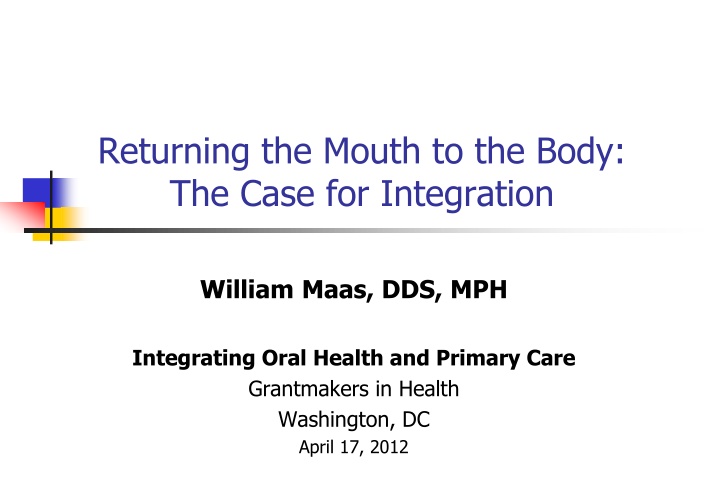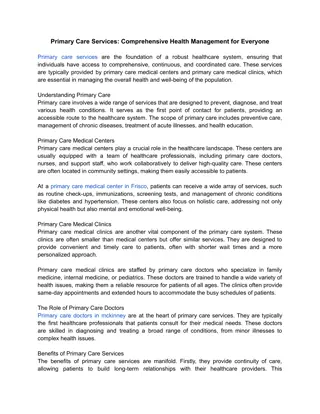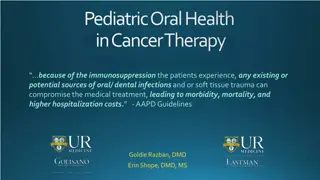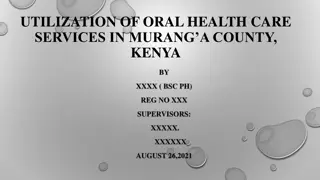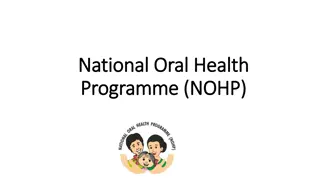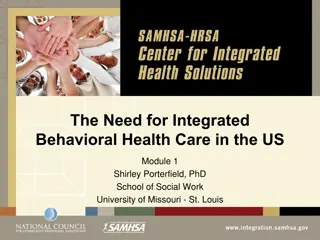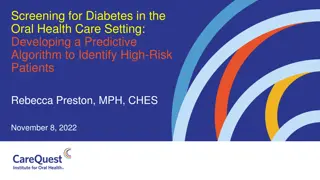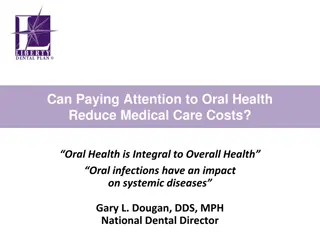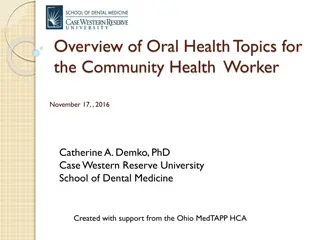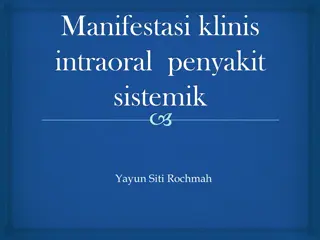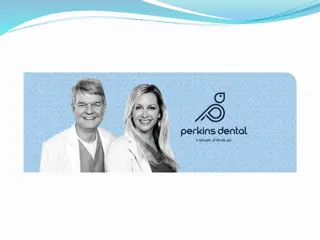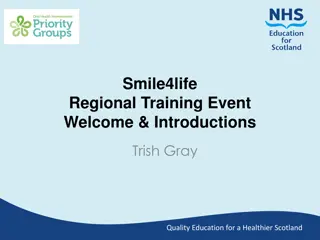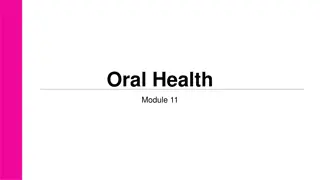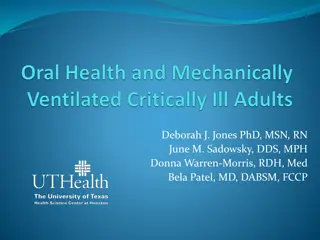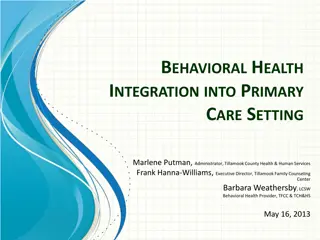Integrating Oral Health and Primary Care: The Case for Integration
The presentation emphasizes the crucial link between oral health and overall well-being, advocating for the integration of dental care with primary healthcare services. It discusses the historical separation of dental and medical care, highlights the significance of oral health for all Americans, addresses common oral health issues like tooth decay and gum disease, and explores barriers to integration. By understanding the interconnectedness of oral and general health, the narrative calls for a more unified approach in healthcare practices.
Download Presentation

Please find below an Image/Link to download the presentation.
The content on the website is provided AS IS for your information and personal use only. It may not be sold, licensed, or shared on other websites without obtaining consent from the author.If you encounter any issues during the download, it is possible that the publisher has removed the file from their server.
You are allowed to download the files provided on this website for personal or commercial use, subject to the condition that they are used lawfully. All files are the property of their respective owners.
The content on the website is provided AS IS for your information and personal use only. It may not be sold, licensed, or shared on other websites without obtaining consent from the author.
E N D
Presentation Transcript
Returning the Mouth to the Body: The Case for Integration William Maas, DDS, MPH Integrating Oral Health and Primary Care Grantmakers in Health Washington, DC April 17, 2012
The Problem The mouth IS connected to the body But professional practices and public policies often don t operate as if it were
The Problem The mouth IS connected to the body And the health of the mouth is important
What we do about oral health matters Oral health is essential to the general health and well-being of all Americans Improved oral health can be achieved by all Americans
What is oral health? Oral health is more than healthy teeth. It being free of diseases and disorders that affect functions we often take for granted, yet represent the very essence of our humanity.
Tooth decay and gum disease Tooth decay the most prevalent chronic disease of childhood, 5x more common than asthma afflicts 90% of people with teeth by age 65 why 25% of seniors have no teeth at all Gum disease associated with poor control of diabetes, poor birth outcomes, heart disease & stroke,
What Ill Cover Historical separation of dental & medical care Surgical versus medical approach Message of Surgeon General s Report Dental problems as infectious diseases Patient centered primary care Rethinking the dental team Barriers to integration
Medicine and Dentistry: Common roots in surgery 1840 Baltimore College of Dental Surgery 1863 nitrous oxide anesthesia first used in NYC 1800s - Health care = surgery or quackery 1910 - Flexner Report & 1926 - Gies Report From trade schools to university-based 1913 - American College of Surgeons 1915 - American College of Physicians
Medicine: Medicine and Surgery advance 1930 American Academy of Pediatrics established 1937 National Cancer Institute established 1938 - Food, Drug and Cosmetic Act 1943 mass production of penicillin 1948 National Heart Institute established 1948 Publication of first Randomized Controlled Trial 1969 Family Medicine established as a distinct specialty 2000 - RCTs advance both medical & surgical approaches
Dentistry: From resignation to repair to prevention 1900 present Dentistry refines repair & rehabilitation Local anesthetic Better drills Better filling material Better cosmetic results 1948 National Institute of Dental Research established Immediately after founding of Cancer and Heart Institute Understanding of dental disease at cellular level begins 1950 Community water fluoridation prevents decay 1955 Crest toothpaste with fluoride introduced
Medicine and Dentistry: Interactive versus Solo Multi-year, hospital-based residencies develop skills in referral among medical specialties and interdisciplinary teams. Only 18% of family medicine docs are solo practitioners With exception of oral surgeons, <1600 dentists per year undertook hospital-based residencies, most only 1 year. In 2008, 59% of dentists were still in solo practice.
Medicine and Dentistry: Financing of Care Hospital insurance for rare, expensive (insurable) events Medical insurance for unpredictable healthcare needs Healthcare insurance for preventive services + the rest Poor with children, well-employed, seniors Dental prepayment for predictable events High copayment for discretionary + rehabilitation Today 50% of expenditures are out-of-pocket. Dental prepayment for middle class (tax subsidy) Dental prepayment for most children
Medicine and Dentistry: Source of Financing of Care Physicians services 31% - Medicaid and Medicare 8% - Out-of-pocket Remainder Subsidized (tax exempt) insurance Dental services <8% - Medicaid (up from <5% in 1970) 41% - Out-of-pocket (down from 90% in 1970) Remainder Subsidized (tax exempt) insurance
First, the good news; then, the bad: The need for action Great progress has been made in reducing the extent and severity of common oral diseases however, not everyone is experiencing the same degree of improvement.
Recognizing profound and consequential disparities: Calling upon all health professions What amounts to a silent epidemic of dental and oral diseases is affecting some population groups There are opportunities for all health professions, to work together to improve health.
Institute of Medicine on Access Improving Access to Oral Health Care for Vulnerable and Underserved Populations
IoM Guiding Principles Oral health is an integral part of overall health and, therefore, oral health care is an essential component of comprehensive health care. Oral health promotion and disease prevention are essential to any strategies aimed at improving access to care.
Oral Health requires access to what? To maintain oral health, individuals require access to: quality oral disease preventive services at regular intervals treatment services when needed -Institute of Medicine, 2011 Timely dependent on decisions of patient & provider Quality determined as safe, timely, effective, efficient, equitable, and patient-centered. -
IoM Recommendations Vision: Rely on a diverse and expanded array of providers who are competent, compensated, and authorized to provide evidence-based care. Stakeholders from both public and private sectors should develop a core set of oral health competencies for NON-dental health care professionals. Competence in oral health care should be required by health professional education programs and for recertification.
Causes of Tooth Decay: The Reductionist View
Advances in dental science Better preventive agents (easier to use, longer lasting, less expensive) Improved diagnostic aides to better characterize risk -> potential for better allocation of effort. Better filling materials (easier to use, longer lasting, less expensive) Medical, not surgical, interventions
What influences biological variables Fisher-Owens, S. A. et al. Pediatrics 2007;120:e510-e520
Contributions to Oral Health DENTAL MEDICAL ORAL HEALTH ENVIRONMENT (SOCIAL, POLITICAL, PHYSICAL)
Tooth decay of preschoolers Fact: In 2004, LESS than 1/3 of kids 2-5 y.o. had cavities. Although many of the rest were high risk (to get cavities later). Risk can be lowered by very simple preventive services and changing the caregivers behavior. For most preschoolers, dentist expertise and one-on- one care is not necessary to lower risk. For many other preschoolers, dentist expertise and one-on-one care is not sufficient to lower risk.
Significance of caries as an infectious disease? A change in perceptions Why did pediatricians and family physicians get involved? If dental caries is an infectious disease, I can do something about that. Our practice is all about preventing infections and controlling them to prevent adverse health outcomes.
Advances in technology: Importation of fluoride varnish Old technology = Professionally applied Fluoride Gels messy, requires suction (special equipment) requires continual attention for 3 minutes New technology = Fluoride Varnish total dose easily controlled, safe for preschoolers no skills or special equipment required (1 minute) Either = a billable service
What influences biological variables Fisher-Owens, S. A. et al. Pediatrics 2007;120:e510-e520
Patient-centered Oral Health Care Care is provided when it is needed, where it can be accessed, customized to needs of child For a young child - is family-centered care Child develops habits and patterns of behavior that are shaped by care-giver Caregiver is target for knowledge and motivation Health professional s assessment based upon care- giver reports as much as direct observations of child
Patient-centered Care The Institute of Medicine names 'patient-centered care' as one of six domains of quality. Research shows that orienting the health system around the preferences and needs of patients has the potential to improve patients' satisfaction with care as well as their clinical outcomes.
All preschoolers need patient-centered oral health care But many preschoolers do not require dental care (i.e. hands on care of a dentist) Who and what most influence parenting practices (espec. diet and hygiene)? Which professionals are best prepared to influence parenting practices? (authority, skills, time) Who has more opportunities to influence parents? Is it realistic to think that dentists, however well trained, can have as great an impact as other disciplines could, collectively?
Oral Health Dream Team Includes health professionals and social services workers to influence parenting and home life: Frequent or timely contact Culturally sensitive, language compatible Expertise is acknowledged, respected Can draw out parental concerns ( M.I.) Offer credible solutions Believe OH is integral to health and well-being Know key behaviors and messages Aware of other team members & referral options
Dentists still have a key role Hold oral health in highest regard Know latest science and guides protocols risk factors prevention tooth preserving techniques dental filling materials Know key behaviors desired and messages being delivered Could be aware of other team members and provide input to referral protocols
Barriers to Integration Communication lack of protocols, common language Communication common electronic health record Uneven financing personal vs societal responsibility Different unit of care fee-for-visit vs fee-for-service Need common curriculum Smiles for Life = good start Professional turf concerns fear loss of respect or $s Others?
Conclusions The mouth is part of the body Dental care is not the same as oral health & vice versa Principles of patient-centered primary care justify more attention to oral health in primary care practices (as well as more attention to non-dental health problems in dental practices) Advances in science/technology will enable more focused & effective interventions that can be delivered by PC Some gaps could be closed by philanthropic investment
Thank You Bill Maas wmaas4bill@verizon.net
